Assignment on Safety Issues in Nursing
VerifiedAdded on 2022/08/27
|7
|1622
|17
AI Summary
Contribute Materials
Your contribution can guide someone’s learning journey. Share your
documents today.
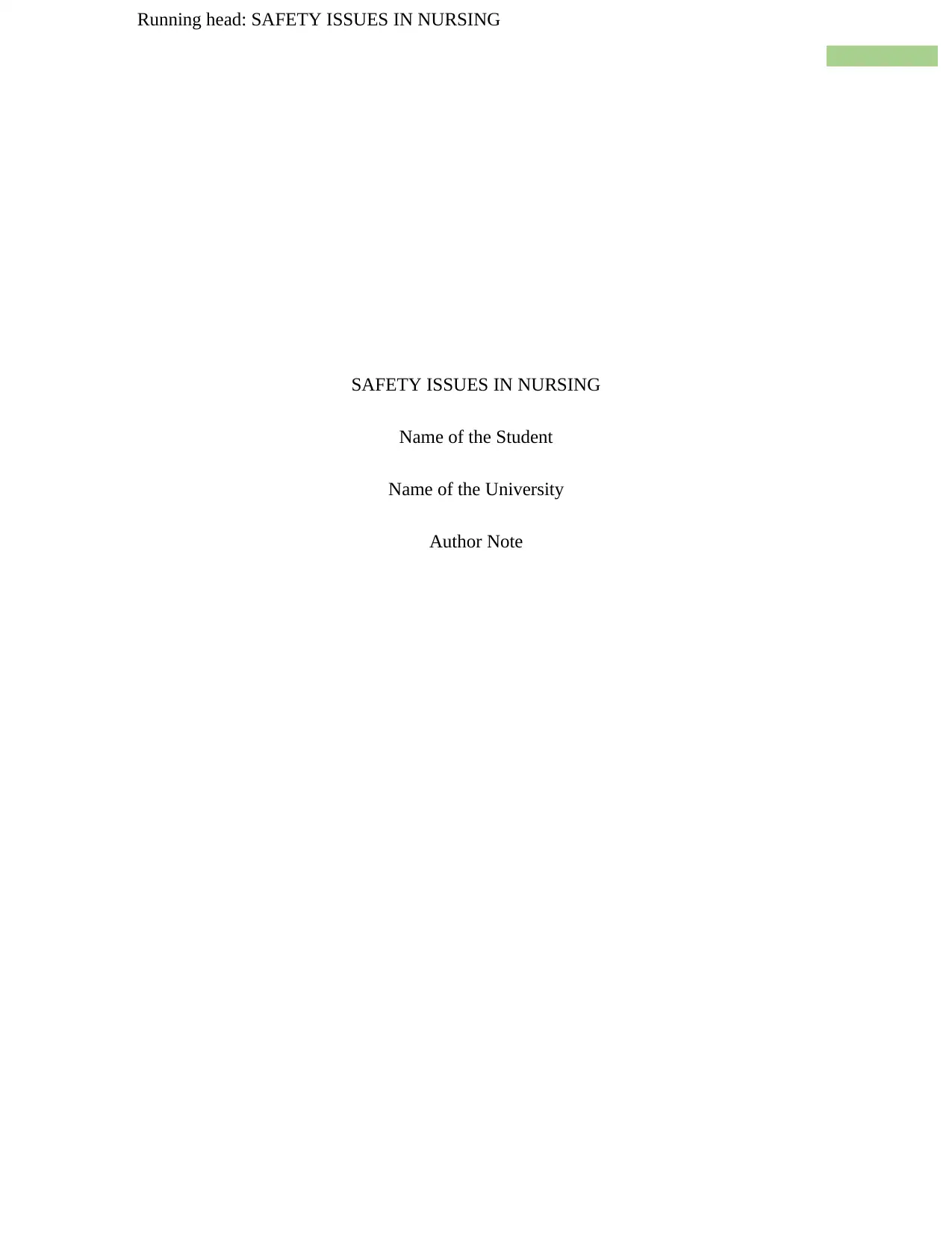
Running head: SAFETY ISSUES IN NURSING
SAFETY ISSUES IN NURSING
Name of the Student
Name of the University
Author Note
SAFETY ISSUES IN NURSING
Name of the Student
Name of the University
Author Note
Secure Best Marks with AI Grader
Need help grading? Try our AI Grader for instant feedback on your assignments.
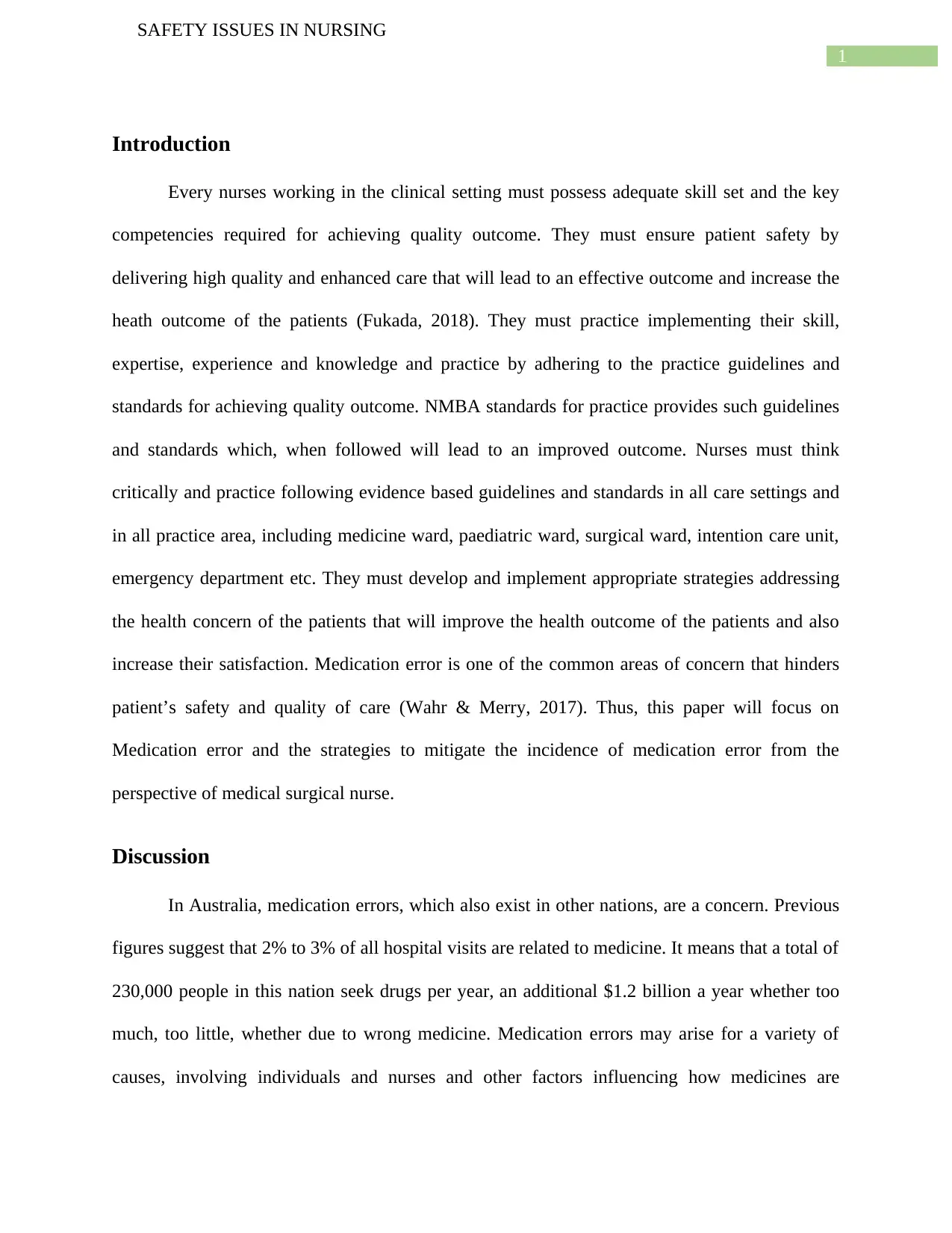
1
SAFETY ISSUES IN NURSING
Introduction
Every nurses working in the clinical setting must possess adequate skill set and the key
competencies required for achieving quality outcome. They must ensure patient safety by
delivering high quality and enhanced care that will lead to an effective outcome and increase the
heath outcome of the patients (Fukada, 2018). They must practice implementing their skill,
expertise, experience and knowledge and practice by adhering to the practice guidelines and
standards for achieving quality outcome. NMBA standards for practice provides such guidelines
and standards which, when followed will lead to an improved outcome. Nurses must think
critically and practice following evidence based guidelines and standards in all care settings and
in all practice area, including medicine ward, paediatric ward, surgical ward, intention care unit,
emergency department etc. They must develop and implement appropriate strategies addressing
the health concern of the patients that will improve the health outcome of the patients and also
increase their satisfaction. Medication error is one of the common areas of concern that hinders
patient’s safety and quality of care (Wahr & Merry, 2017). Thus, this paper will focus on
Medication error and the strategies to mitigate the incidence of medication error from the
perspective of medical surgical nurse.
Discussion
In Australia, medication errors, which also exist in other nations, are a concern. Previous
figures suggest that 2% to 3% of all hospital visits are related to medicine. It means that a total of
230,000 people in this nation seek drugs per year, an additional $1.2 billion a year whether too
much, too little, whether due to wrong medicine. Medication errors may arise for a variety of
causes, involving individuals and nurses and other factors influencing how medicines are
SAFETY ISSUES IN NURSING
Introduction
Every nurses working in the clinical setting must possess adequate skill set and the key
competencies required for achieving quality outcome. They must ensure patient safety by
delivering high quality and enhanced care that will lead to an effective outcome and increase the
heath outcome of the patients (Fukada, 2018). They must practice implementing their skill,
expertise, experience and knowledge and practice by adhering to the practice guidelines and
standards for achieving quality outcome. NMBA standards for practice provides such guidelines
and standards which, when followed will lead to an improved outcome. Nurses must think
critically and practice following evidence based guidelines and standards in all care settings and
in all practice area, including medicine ward, paediatric ward, surgical ward, intention care unit,
emergency department etc. They must develop and implement appropriate strategies addressing
the health concern of the patients that will improve the health outcome of the patients and also
increase their satisfaction. Medication error is one of the common areas of concern that hinders
patient’s safety and quality of care (Wahr & Merry, 2017). Thus, this paper will focus on
Medication error and the strategies to mitigate the incidence of medication error from the
perspective of medical surgical nurse.
Discussion
In Australia, medication errors, which also exist in other nations, are a concern. Previous
figures suggest that 2% to 3% of all hospital visits are related to medicine. It means that a total of
230,000 people in this nation seek drugs per year, an additional $1.2 billion a year whether too
much, too little, whether due to wrong medicine. Medication errors may arise for a variety of
causes, involving individuals and nurses and other factors influencing how medicines are
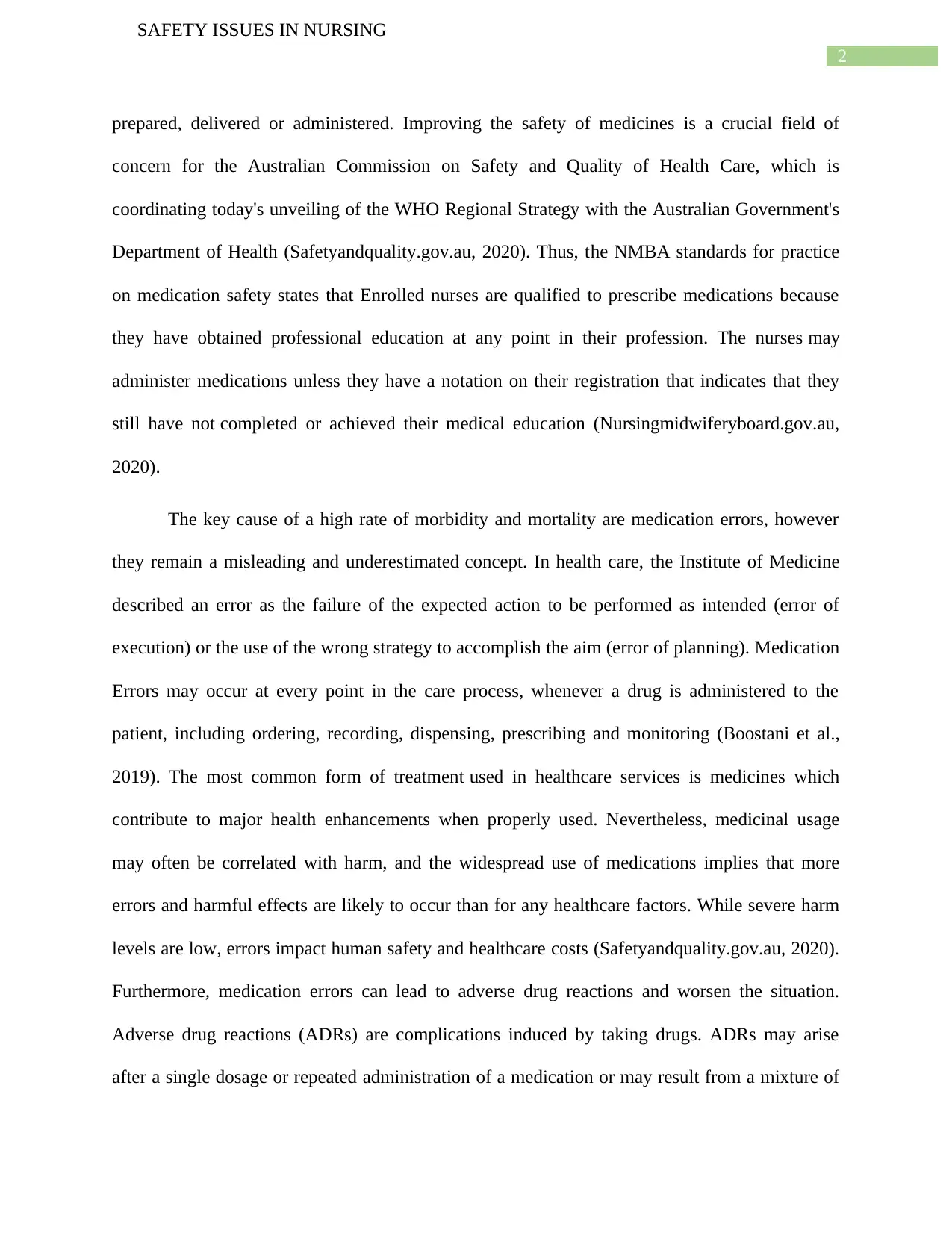
2
SAFETY ISSUES IN NURSING
prepared, delivered or administered. Improving the safety of medicines is a crucial field of
concern for the Australian Commission on Safety and Quality of Health Care, which is
coordinating today's unveiling of the WHO Regional Strategy with the Australian Government's
Department of Health (Safetyandquality.gov.au, 2020). Thus, the NMBA standards for practice
on medication safety states that Enrolled nurses are qualified to prescribe medications because
they have obtained professional education at any point in their profession. The nurses may
administer medications unless they have a notation on their registration that indicates that they
still have not completed or achieved their medical education (Nursingmidwiferyboard.gov.au,
2020).
The key cause of a high rate of morbidity and mortality are medication errors, however
they remain a misleading and underestimated concept. In health care, the Institute of Medicine
described an error as the failure of the expected action to be performed as intended (error of
execution) or the use of the wrong strategy to accomplish the aim (error of planning). Medication
Errors may occur at every point in the care process, whenever a drug is administered to the
patient, including ordering, recording, dispensing, prescribing and monitoring (Boostani et al.,
2019). The most common form of treatment used in healthcare services is medicines which
contribute to major health enhancements when properly used. Nevertheless, medicinal usage
may often be correlated with harm, and the widespread use of medications implies that more
errors and harmful effects are likely to occur than for any healthcare factors. While severe harm
levels are low, errors impact human safety and healthcare costs (Safetyandquality.gov.au, 2020).
Furthermore, medication errors can lead to adverse drug reactions and worsen the situation.
Adverse drug reactions (ADRs) are complications induced by taking drugs. ADRs may arise
after a single dosage or repeated administration of a medication or may result from a mixture of
SAFETY ISSUES IN NURSING
prepared, delivered or administered. Improving the safety of medicines is a crucial field of
concern for the Australian Commission on Safety and Quality of Health Care, which is
coordinating today's unveiling of the WHO Regional Strategy with the Australian Government's
Department of Health (Safetyandquality.gov.au, 2020). Thus, the NMBA standards for practice
on medication safety states that Enrolled nurses are qualified to prescribe medications because
they have obtained professional education at any point in their profession. The nurses may
administer medications unless they have a notation on their registration that indicates that they
still have not completed or achieved their medical education (Nursingmidwiferyboard.gov.au,
2020).
The key cause of a high rate of morbidity and mortality are medication errors, however
they remain a misleading and underestimated concept. In health care, the Institute of Medicine
described an error as the failure of the expected action to be performed as intended (error of
execution) or the use of the wrong strategy to accomplish the aim (error of planning). Medication
Errors may occur at every point in the care process, whenever a drug is administered to the
patient, including ordering, recording, dispensing, prescribing and monitoring (Boostani et al.,
2019). The most common form of treatment used in healthcare services is medicines which
contribute to major health enhancements when properly used. Nevertheless, medicinal usage
may often be correlated with harm, and the widespread use of medications implies that more
errors and harmful effects are likely to occur than for any healthcare factors. While severe harm
levels are low, errors impact human safety and healthcare costs (Safetyandquality.gov.au, 2020).
Furthermore, medication errors can lead to adverse drug reactions and worsen the situation.
Adverse drug reactions (ADRs) are complications induced by taking drugs. ADRs may arise
after a single dosage or repeated administration of a medication or may result from a mixture of
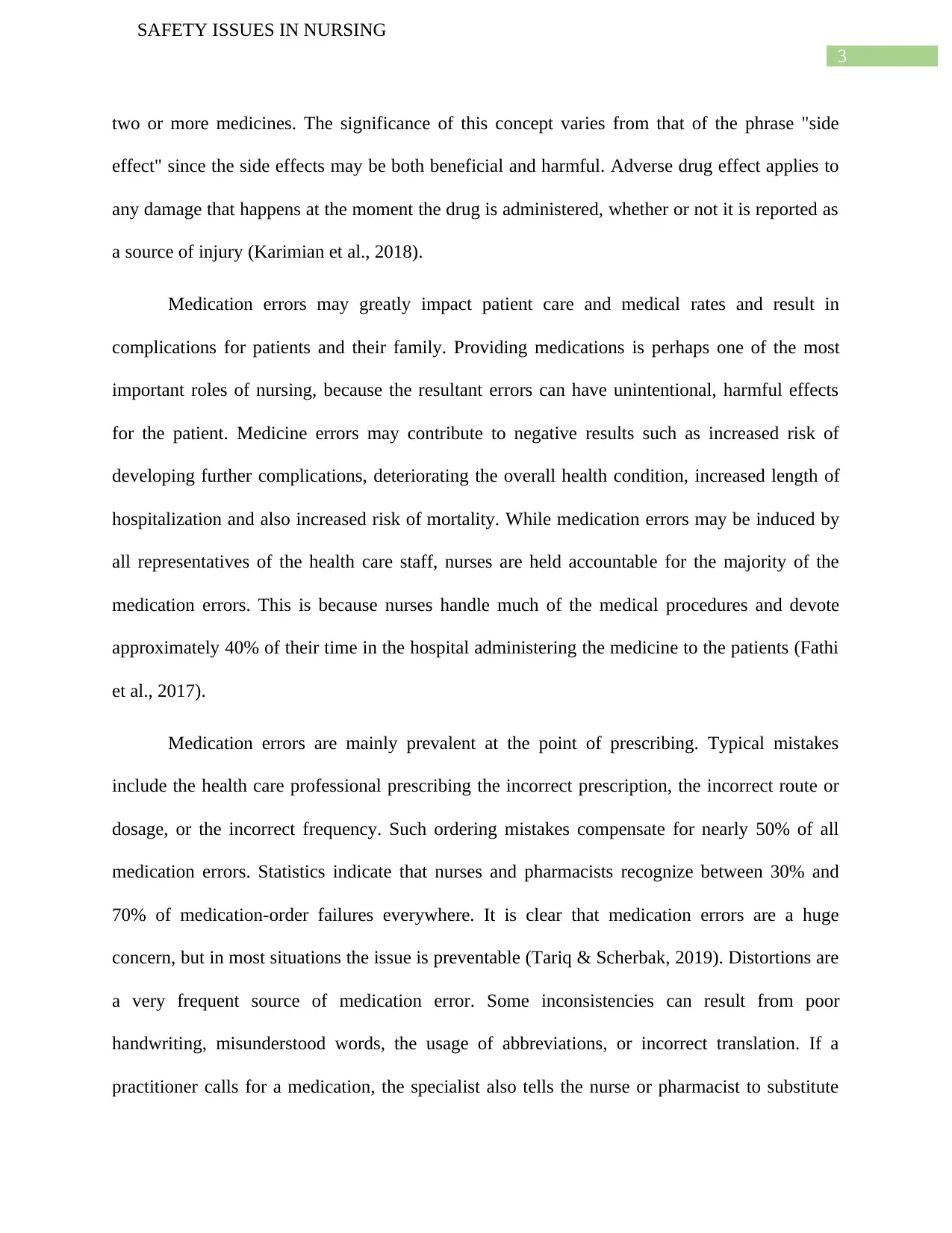
3
SAFETY ISSUES IN NURSING
two or more medicines. The significance of this concept varies from that of the phrase "side
effect" since the side effects may be both beneficial and harmful. Adverse drug effect applies to
any damage that happens at the moment the drug is administered, whether or not it is reported as
a source of injury (Karimian et al., 2018).
Medication errors may greatly impact patient care and medical rates and result in
complications for patients and their family. Providing medications is perhaps one of the most
important roles of nursing, because the resultant errors can have unintentional, harmful effects
for the patient. Medicine errors may contribute to negative results such as increased risk of
developing further complications, deteriorating the overall health condition, increased length of
hospitalization and also increased risk of mortality. While medication errors may be induced by
all representatives of the health care staff, nurses are held accountable for the majority of the
medication errors. This is because nurses handle much of the medical procedures and devote
approximately 40% of their time in the hospital administering the medicine to the patients (Fathi
et al., 2017).
Medication errors are mainly prevalent at the point of prescribing. Typical mistakes
include the health care professional prescribing the incorrect prescription, the incorrect route or
dosage, or the incorrect frequency. Such ordering mistakes compensate for nearly 50% of all
medication errors. Statistics indicate that nurses and pharmacists recognize between 30% and
70% of medication-order failures everywhere. It is clear that medication errors are a huge
concern, but in most situations the issue is preventable (Tariq & Scherbak, 2019). Distortions are
a very frequent source of medication error. Some inconsistencies can result from poor
handwriting, misunderstood words, the usage of abbreviations, or incorrect translation. If a
practitioner calls for a medication, the specialist also tells the nurse or pharmacist to substitute
SAFETY ISSUES IN NURSING
two or more medicines. The significance of this concept varies from that of the phrase "side
effect" since the side effects may be both beneficial and harmful. Adverse drug effect applies to
any damage that happens at the moment the drug is administered, whether or not it is reported as
a source of injury (Karimian et al., 2018).
Medication errors may greatly impact patient care and medical rates and result in
complications for patients and their family. Providing medications is perhaps one of the most
important roles of nursing, because the resultant errors can have unintentional, harmful effects
for the patient. Medicine errors may contribute to negative results such as increased risk of
developing further complications, deteriorating the overall health condition, increased length of
hospitalization and also increased risk of mortality. While medication errors may be induced by
all representatives of the health care staff, nurses are held accountable for the majority of the
medication errors. This is because nurses handle much of the medical procedures and devote
approximately 40% of their time in the hospital administering the medicine to the patients (Fathi
et al., 2017).
Medication errors are mainly prevalent at the point of prescribing. Typical mistakes
include the health care professional prescribing the incorrect prescription, the incorrect route or
dosage, or the incorrect frequency. Such ordering mistakes compensate for nearly 50% of all
medication errors. Statistics indicate that nurses and pharmacists recognize between 30% and
70% of medication-order failures everywhere. It is clear that medication errors are a huge
concern, but in most situations the issue is preventable (Tariq & Scherbak, 2019). Distortions are
a very frequent source of medication error. Some inconsistencies can result from poor
handwriting, misunderstood words, the usage of abbreviations, or incorrect translation. If a
practitioner calls for a medication, the specialist also tells the nurse or pharmacist to substitute
Secure Best Marks with AI Grader
Need help grading? Try our AI Grader for instant feedback on your assignments.
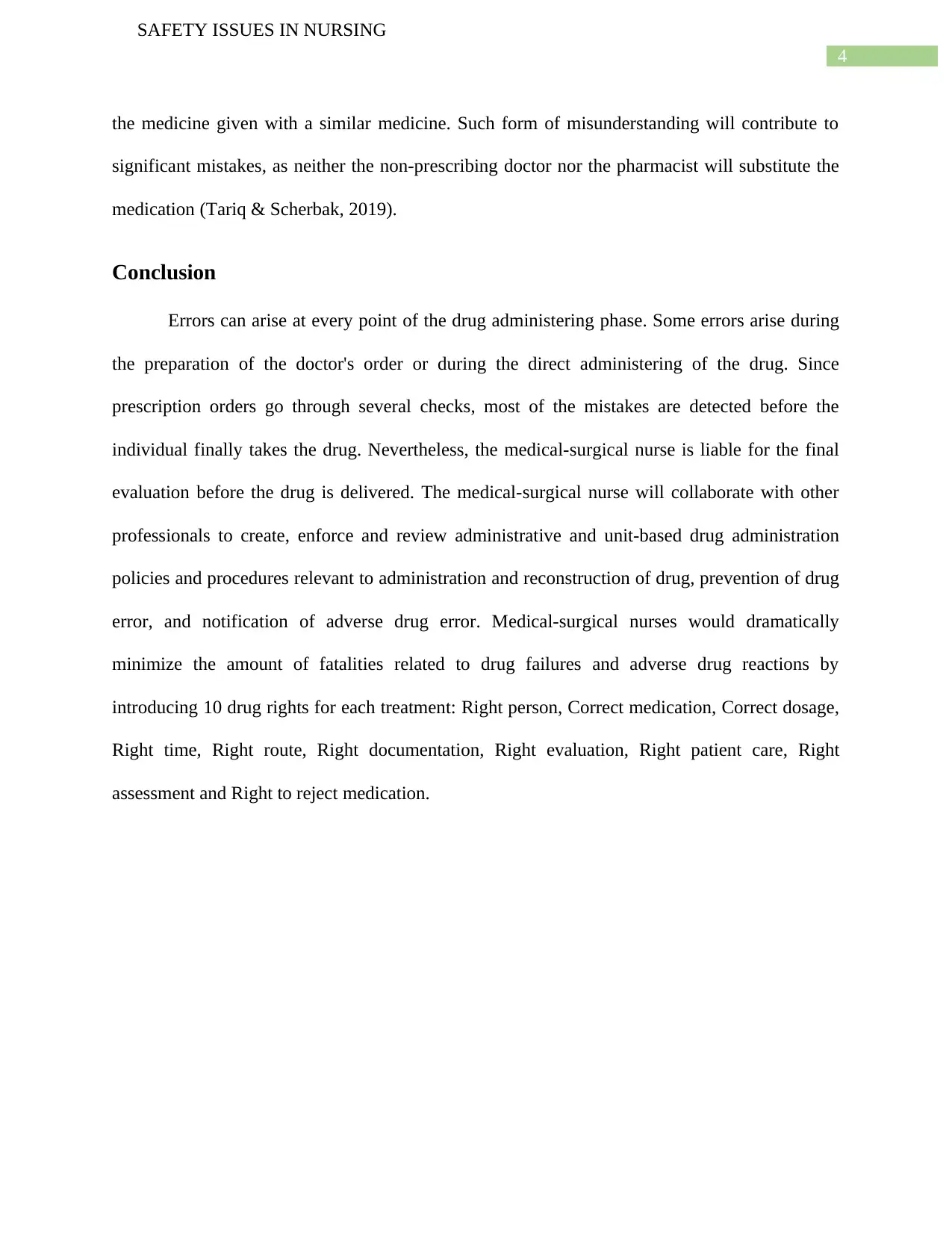
4
SAFETY ISSUES IN NURSING
the medicine given with a similar medicine. Such form of misunderstanding will contribute to
significant mistakes, as neither the non-prescribing doctor nor the pharmacist will substitute the
medication (Tariq & Scherbak, 2019).
Conclusion
Errors can arise at every point of the drug administering phase. Some errors arise during
the preparation of the doctor's order or during the direct administering of the drug. Since
prescription orders go through several checks, most of the mistakes are detected before the
individual finally takes the drug. Nevertheless, the medical-surgical nurse is liable for the final
evaluation before the drug is delivered. The medical-surgical nurse will collaborate with other
professionals to create, enforce and review administrative and unit-based drug administration
policies and procedures relevant to administration and reconstruction of drug, prevention of drug
error, and notification of adverse drug error. Medical-surgical nurses would dramatically
minimize the amount of fatalities related to drug failures and adverse drug reactions by
introducing 10 drug rights for each treatment: Right person, Correct medication, Correct dosage,
Right time, Right route, Right documentation, Right evaluation, Right patient care, Right
assessment and Right to reject medication.
SAFETY ISSUES IN NURSING
the medicine given with a similar medicine. Such form of misunderstanding will contribute to
significant mistakes, as neither the non-prescribing doctor nor the pharmacist will substitute the
medication (Tariq & Scherbak, 2019).
Conclusion
Errors can arise at every point of the drug administering phase. Some errors arise during
the preparation of the doctor's order or during the direct administering of the drug. Since
prescription orders go through several checks, most of the mistakes are detected before the
individual finally takes the drug. Nevertheless, the medical-surgical nurse is liable for the final
evaluation before the drug is delivered. The medical-surgical nurse will collaborate with other
professionals to create, enforce and review administrative and unit-based drug administration
policies and procedures relevant to administration and reconstruction of drug, prevention of drug
error, and notification of adverse drug error. Medical-surgical nurses would dramatically
minimize the amount of fatalities related to drug failures and adverse drug reactions by
introducing 10 drug rights for each treatment: Right person, Correct medication, Correct dosage,
Right time, Right route, Right documentation, Right evaluation, Right patient care, Right
assessment and Right to reject medication.
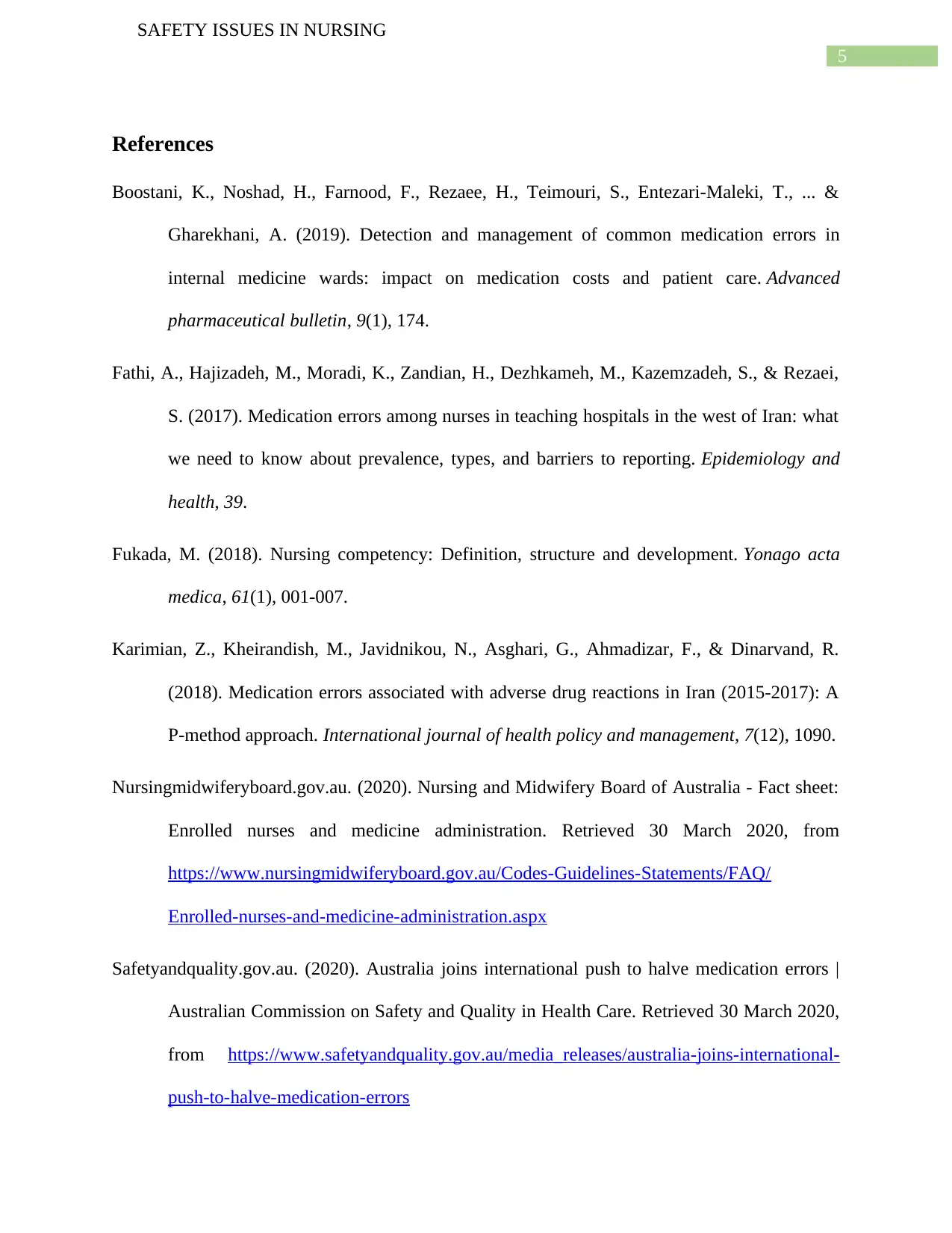
5
SAFETY ISSUES IN NURSING
References
Boostani, K., Noshad, H., Farnood, F., Rezaee, H., Teimouri, S., Entezari-Maleki, T., ... &
Gharekhani, A. (2019). Detection and management of common medication errors in
internal medicine wards: impact on medication costs and patient care. Advanced
pharmaceutical bulletin, 9(1), 174.
Fathi, A., Hajizadeh, M., Moradi, K., Zandian, H., Dezhkameh, M., Kazemzadeh, S., & Rezaei,
S. (2017). Medication errors among nurses in teaching hospitals in the west of Iran: what
we need to know about prevalence, types, and barriers to reporting. Epidemiology and
health, 39.
Fukada, M. (2018). Nursing competency: Definition, structure and development. Yonago acta
medica, 61(1), 001-007.
Karimian, Z., Kheirandish, M., Javidnikou, N., Asghari, G., Ahmadizar, F., & Dinarvand, R.
(2018). Medication errors associated with adverse drug reactions in Iran (2015-2017): A
P-method approach. International journal of health policy and management, 7(12), 1090.
Nursingmidwiferyboard.gov.au. (2020). Nursing and Midwifery Board of Australia - Fact sheet:
Enrolled nurses and medicine administration. Retrieved 30 March 2020, from
https://www.nursingmidwiferyboard.gov.au/Codes-Guidelines-Statements/FAQ/
Enrolled-nurses-and-medicine-administration.aspx
Safetyandquality.gov.au. (2020). Australia joins international push to halve medication errors |
Australian Commission on Safety and Quality in Health Care. Retrieved 30 March 2020,
from https://www.safetyandquality.gov.au/media_releases/australia-joins-international-
push-to-halve-medication-errors
SAFETY ISSUES IN NURSING
References
Boostani, K., Noshad, H., Farnood, F., Rezaee, H., Teimouri, S., Entezari-Maleki, T., ... &
Gharekhani, A. (2019). Detection and management of common medication errors in
internal medicine wards: impact on medication costs and patient care. Advanced
pharmaceutical bulletin, 9(1), 174.
Fathi, A., Hajizadeh, M., Moradi, K., Zandian, H., Dezhkameh, M., Kazemzadeh, S., & Rezaei,
S. (2017). Medication errors among nurses in teaching hospitals in the west of Iran: what
we need to know about prevalence, types, and barriers to reporting. Epidemiology and
health, 39.
Fukada, M. (2018). Nursing competency: Definition, structure and development. Yonago acta
medica, 61(1), 001-007.
Karimian, Z., Kheirandish, M., Javidnikou, N., Asghari, G., Ahmadizar, F., & Dinarvand, R.
(2018). Medication errors associated with adverse drug reactions in Iran (2015-2017): A
P-method approach. International journal of health policy and management, 7(12), 1090.
Nursingmidwiferyboard.gov.au. (2020). Nursing and Midwifery Board of Australia - Fact sheet:
Enrolled nurses and medicine administration. Retrieved 30 March 2020, from
https://www.nursingmidwiferyboard.gov.au/Codes-Guidelines-Statements/FAQ/
Enrolled-nurses-and-medicine-administration.aspx
Safetyandquality.gov.au. (2020). Australia joins international push to halve medication errors |
Australian Commission on Safety and Quality in Health Care. Retrieved 30 March 2020,
from https://www.safetyandquality.gov.au/media_releases/australia-joins-international-
push-to-halve-medication-errors
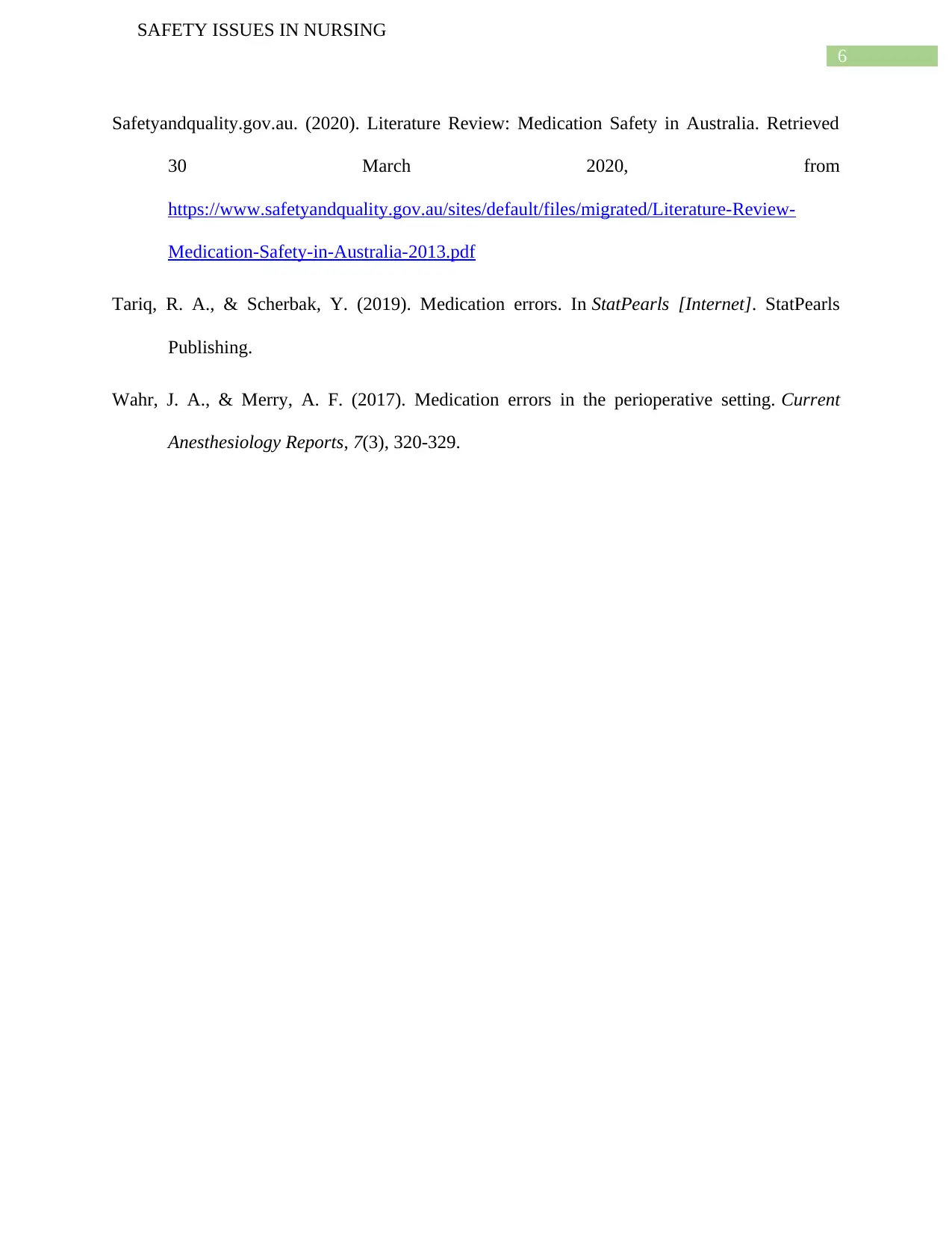
6
SAFETY ISSUES IN NURSING
Safetyandquality.gov.au. (2020). Literature Review: Medication Safety in Australia. Retrieved
30 March 2020, from
https://www.safetyandquality.gov.au/sites/default/files/migrated/Literature-Review-
Medication-Safety-in-Australia-2013.pdf
Tariq, R. A., & Scherbak, Y. (2019). Medication errors. In StatPearls [Internet]. StatPearls
Publishing.
Wahr, J. A., & Merry, A. F. (2017). Medication errors in the perioperative setting. Current
Anesthesiology Reports, 7(3), 320-329.
SAFETY ISSUES IN NURSING
Safetyandquality.gov.au. (2020). Literature Review: Medication Safety in Australia. Retrieved
30 March 2020, from
https://www.safetyandquality.gov.au/sites/default/files/migrated/Literature-Review-
Medication-Safety-in-Australia-2013.pdf
Tariq, R. A., & Scherbak, Y. (2019). Medication errors. In StatPearls [Internet]. StatPearls
Publishing.
Wahr, J. A., & Merry, A. F. (2017). Medication errors in the perioperative setting. Current
Anesthesiology Reports, 7(3), 320-329.
1 out of 7
Related Documents
Your All-in-One AI-Powered Toolkit for Academic Success.
+13062052269
info@desklib.com
Available 24*7 on WhatsApp / Email
![[object Object]](/_next/static/media/star-bottom.7253800d.svg)
Unlock your academic potential
© 2024 | Zucol Services PVT LTD | All rights reserved.





